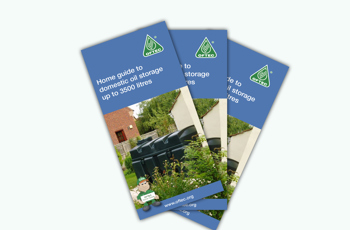Home guide to domestic liquid fuel storage up to 3500 litres
The information on this page provides general guidance; your local OFTEC registered technician will be able to provide further advice on your particular circumstances.
In 2021, oil (kerosene) continues to be the most widely used fuel in off-grid homes. However, to reflect that a renewable liquid fuel, such as HVO may soon be available (see our future heating section) we have used the term liquid fuel in this guide to include both oil and low carbon liquid fuels.
The guidance relating to fuel storage tanks applies to fuel storage tanks up to 3500 litres capacity supplying liquid fuel to domestic properties. Fuel storage tank installations must comply with regional building regulations.
For information on larger tanks or non-residential sites, please email OFTEC’s technical team.
In England and Wales, OFTEC registered technicians can self-certify that their work complies with building regulations. If you use an installer that isn’t registered with a competent person scheme, such as OFTEC, then you will need to obtain a Building Control Notice and arrange for an inspection, which can be costly and time consuming. In Scotland, you may need to apply for a warrant.
About your fuel storage tank
Modern fuel storage tanks come in all shapes and sizes and can be made from plastic or steel to suit your individual requirements. It is recommended that the chosen tank is manufactured to OFTEC Standards (OFS T100 for plastic or OFS T200 for steel). In some regions, to minimise pollution risk from fuel spills, it is now mandatory for tanks to be bunded. This means there is secondary containment either integral to the tank or built around it. In other regions your OFTEC registered technician will conduct a risk assessment and advise accordingly, but typically tank installations near a river, well, or any controlled water will require bunding. Fuel tanks have an expected working life of around 20 years with the risk of a costly tank failure increasing with age. Your fuel tank should be inspected every year as part of your annual heating system service and your technician will advise you when you should replace your tank. Your fuel delivery contractor may also highlight issues with your tank and, in extreme cases, could refuse to deliver if they have concerns about the tank’s condition. It is common practice for a contractor to apply a warning notice to a fuel storage tank in addition to reporting any defects to you.
Tank support
If a fuel storage tank is not adequately supported, it could lead to safety concerns, the eventual failure of the tank and even a fuel spill. The base needs to provide continual structural support, even though ground conditions may vary from season to season. The base should be:
Adequate for the weight of the tank and its contents – 1000 litres of fuel weighs just under a ton;
- Non-combustible, imperforate and level;
- Constructed of concrete, paving stones or stonework;
- Large enough to extend 300mm beyond all sides of the tank.
What are the regulations on location of a liquid fuel tank?
There are now very specific rules governing the location of tanks and it’s important to take these rules into account if you are making subsequent changes to your property. The rules are in place for fire safety reasons and although a fire is highly unlikely to originate in a fuel storage tank, it is very important to protect the stored fuel from fires or heat sources nearby. To protect tanks from an ignition source, tanks should be sited:
- 1.8m away from non-fire rated eaves of a building
- 1.8m away from a non-fire rated building or structure (e.g. garden sheds)
- 1.8m away from openings (such as doors or windows) in a fire rated building or structure (e.g. brick-built house/garage)
- 1.8m away from liquid fuel appliance flue terminals
- 760mm away from a non-fire rated boundary, such as a wooden boundary fence
- 600mm away from screening (e.g. trellis and foliage) that does not form part of the boundary.
If it is impossible to comply with the separation distances, then a fire protection barrier (with a minimum 30 minutes fire rating) should be provided. The separation distance required between the tank and the fire barrier should be a minimal 300mm unless a greater distance is specified by the tank manufacturer. It is possible to site a fuel storage tank inside a garage or out-house; however, they need to be self-contained within a 60-minute fire rated chamber.
Looking after your fuel storage tank
It is your responsibility to maintain the fuel storage tank on your property – spills and leaks can be extremely costly to clean up and can cause contamination to ground water supplies or even building foundations. It is important that you check whether your home insurance covers fuel spills or leaks and whether there are any stipulations or limitations to your policy. Tanks should be visually checked by a competent person at the time of your annual appliance service visit. OFTEC also recommends regularly carrying out a visual check between service visits and particularly after periods of extreme weather conditions as this can put tanks under additional stress. These are some of the warning signs to look out for:
- Rust
- Splits or cracks
- Bulging
- Gauges falling over or not working
- Subsidence on the base
- Sudden increase in usage of fuel
- Tanks overgrown with foliage
- Strong fuel smell
If you have any concerns, always contact your local OFTEC registered technician who can advise fully.
Please wait ...


